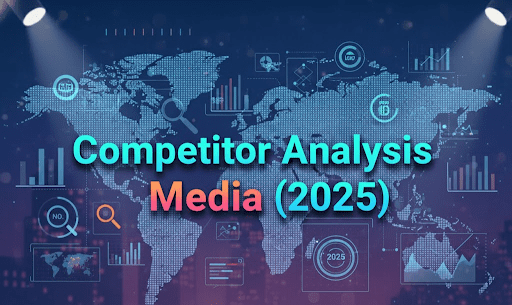A Strategist’s Guide to Competitor Analysis in Media (2025)

Introduction
In the hyper-competitive global media landscape, success is no longer solely defined by the quality of your content; it is increasingly determined by the quality of your strategy.
A critical component of that strategy is a deep and continuous understanding of your rivals’ movements. Proactive competitor analysis in media is not a passive, academic exercise—it is an offensive and defensive tool that allows executives to anticipate market shifts, identify untapped opportunities, and mitigate threats before they fully materialize.
The traditional approach of relying on industry buzz or annual reports is dangerously reactive. To win in today’s market, decision-makers need a systematic, real-time method for tracking what competitors are developing, financing, and bringing to market.
This guide outlines a strategic framework for conducting this essential intelligence work.
Table of content
- The Need for Real-Time Intelligence
- Step 1: Mapping the Competitive Landscape
- Step 2: Tracking the Content Pipeline
- Step 3: Analyzing Strategic Intent
- Step 4: Integrating Intelligence into Decision-Making
- The Ultimate Tool for Competitor Analysis in Media
- Conclusion: From Reactive Analysis to Proactive Strategy
- Frequently Asked Questions
Key Takeaways
| Core Challenge | Gaining real-time visibility into competitors’ project pipelines and strategic priorities is nearly impossible with traditional, lagging-indicator sources. |
| Strategic Solution | Implement a real-time project tracking system to monitor competitor activity from the earliest stages of development through to production. |
| Vitrina’s Role | Vitrina’s Projects Tracker API provides live, structured data on the global content pipeline, serving as the ultimate competitive intelligence tool. |
The Need for Real-Time Intelligence
The pace of the modern media industry is relentless. Strategic decisions that once took months are now made in weeks. In this environment, relying on lagging indicators like quarterly earnings calls or trade-press announcements for competitor insights means you are already several steps behind.
By the time a competitor announces a new series, it has been in development for months, if not years. The real strategic advantage lies in knowing what your rivals are planning long before it becomes public knowledge.
Effective competitor analysis provides the early warning system needed to make agile, informed decisions. It is a foundational element of building a robust competitive and market intelligence function within your organization.
According to a strategic framework from Asana, a thorough analysis should detail not just a competitor’s products, but also their marketing strategies and market positioning. In the M&E industry, a competitor’s “product” is its content slate, making pipeline visibility the most critical data set.
Step 1: Mapping the Competitive Landscape
Before you can track your competitors, you must accurately define them. The landscape is often more complex than it appears, and your analysis should include multiple tiers of rivals.
- Direct Competitors: These are the most obvious rivals—the studios, streamers, or production companies that create similar content and target the same audience demographic. (e.g., Netflix and Disney+).
- Indirect Competitors: These companies may not produce the exact same type of content but compete for the same share of audience attention and leisure time (e.g., a major broadcast network and a gaming platform like Twitch).
- Emerging Competitors: These are new, often well-funded players entering the market who could disrupt the existing order. Identifying these disruptors early is crucial.
A comprehensive map of this landscape is the essential first step, ensuring your intelligence gathering is focused and relevant.
Step 2: Tracking the Content Pipeline for Competitor Analysis in Media
This is the core of effective competitor analysis in media. The goal is to gain visibility into your rivals’ content pipelines at every stage. This intelligence allows you to answer the most critical strategic questions:
- Development Stage: What books, comics, or original scripts are they optioning? Which genres and themes are they exploring? This provides the earliest possible indicator of their future strategic direction.
- Financing Stage: Which projects are they actively financing? Are they pursuing international co-production deals? This reveals their level of commitment and investment in specific projects.
- Production Stage: Which projects have officially been greenlit and are moving into principal photography? This signals that a project is locked in and will be coming to market.
Tracking projects as they move through these stages provides a dynamic, forward-looking view of a competitor’s strategy, moving far beyond the static analysis of what they have already released. For more detail on these stages, see our guide to development and pre-production.
Step 3: Analyzing Strategic Intent
Data without analysis is just noise. Once you are tracking the movement of competitor projects, the next step is to interpret the strategic intent behind their decisions.
- Identify Patterns: Are they consistently investing in a particular genre, like true crime documentaries or YA fantasy? A pattern of investment indicates a deliberate strategic focus.
- Assess Risk Profile: Are they financing big-budget, high-risk projects based on unproven IP, or are they focusing on safer, established franchises? This reveals their appetite for risk.
- Map Market Focus: Are they developing content specifically for emerging markets like Southeast Asia or Latin America? This signals their global expansion priorities.
This analysis transforms raw data on project movements into actionable intelligence about a competitor’s overarching strategy, allowing you to anticipate their next move.
Step 4: Integrating Intelligence into Decision-Making
The final, and most important, step is to embed this competitive intelligence directly into your own strategic decision-making processes.
- For Content Strategy: If you see multiple competitors moving heavily into a specific genre, you can make a strategic choice: either enter the space to compete directly or pivot to an underserved niche where there is less competition.
- For Mergers & Acquisitions: Tracking the development slates of smaller, independent production companies can help you identify potential acquisition targets with valuable IP.
- For Partnership and Co-Production: Knowing which companies are actively seeking financing for projects that align with your own slate can reveal powerful co-production opportunities.
Competitive intelligence is only valuable when it is used to inform and improve your own strategic choices, providing a tangible return on the investment in data and analysis.
The Ultimate Tool for Competitor Analysis in Media
The core challenge in executing this framework is access to reliable, real-time data on project pipelines. This information is proprietary and notoriously difficult to obtain through public sources alone. This is where a specialized intelligence tool becomes indispensable.
The Vitrina Projects Tracker API was purpose-built to solve this exact problem. It provides a live, structured feed of data on film and TV projects from the earliest stages of development through to production and release.
This is the same tool used by global leaders like Netflix and Globo for their own internal competitor analysis in media.
By integrating our API directly into their CXO dashboards and CRM systems, these companies gain a persistent, real-time view of the entire global content landscape.
This allows them to automate the tracking process and focus their resources on the high-value work of analysis and strategic response, creating a significant and sustainable competitive advantage.
The API is also a primary lead-generation tool for service companies like Panavision and Toonz Media, who use it to identify projects entering production or post-production.
Conclusion: From Reactive Analysis to Proactive Strategy
In the fast-paced, high-stakes media industry, proactive competitor analysis is no longer a luxury—it is a core requirement for survival and growth.
By moving beyond outdated, reactive methods and implementing a systematic, real-time approach to tracking and analyzing competitor project pipelines, you can transform your strategic planning process.
This provides the foresight needed to not only react to market changes but to anticipate them, allowing you to seize opportunities, mitigate risks, and consistently outmaneuver the competition.
Frequently Asked Questions
The main goal is to gain a strategic advantage by understanding a competitor’s content strategy before it becomes public. This involves tracking their project pipeline to see what they are developing, financing, and producing, which allows you to anticipate market trends and make more informed decisions.
Traditionally, this involves monitoring trade press and industry contacts. However, a more effective modern approach is to use a specialized market intelligence tool or API that aggregates data on projects from the earliest development stages, providing a real-time view of the content pipeline.
Real-time data is critical because the media industry moves extremely fast. By the time a competitor publicly announces a new show, key strategic decisions were made months or years prior. Real-time tracking of projects in development gives you an early warning system to react and adjust your own strategy proactively.
For service companies (like post-production or VFX studios), tracking competitor projects is a powerful lead generation tool. By identifying projects that are about to enter the production or post-production phase, these companies can reach out with their services at the exact moment they are needed.

























